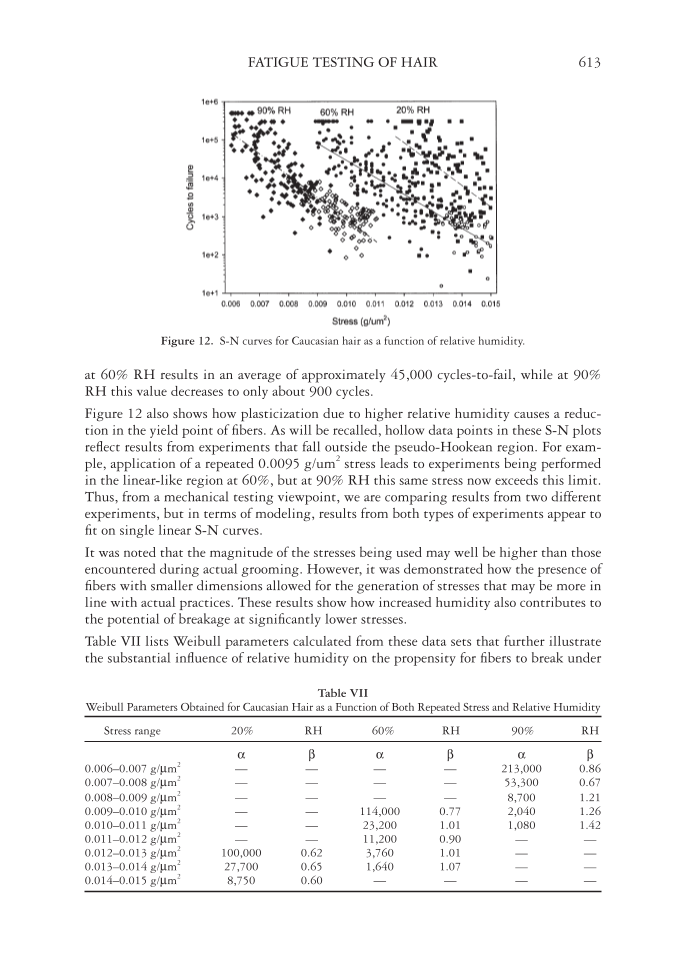FATIGUE TESTING OF HAIR 613 at 60% RH results in an average of approximately 45,000 cycles-to-fail, while at 90% RH this value decreases to only about 900 cycles. Figure 12 also shows how plasticization due to higher relative humidity causes a reduc- tion in the yield point of fi bers. As will be recalled, hollow data points in these S-N plots refl ect results from experiments that fall outside the pseudo-Hookean region. For exam- ple, application of a repeated 0.0095 g/um2 stress leads to experiments being performed in the linear-like region at 60%, but at 90% RH this same stress now exceeds this limit. Thus, from a mechanical testing viewpoint, we are comparing results from two different experiments, but in terms of modeling, results from both types of experiments appear to fi t on single linear S-N curves. It was noted that the magnitude of the stresses being used may well be higher than those encountered during actual grooming. However, it was demonstrated how the presence of fi bers with smaller dimensions allowed for the generation of stresses that may be more in line with actual practices. These results show how increased humidity also contributes to the potential of breakage at signifi cantly lower stresses. Table VII lists Weibull parameters calculated from these data sets that further illustrate the substantial infl uence of relative humidity on the propensity for fi bers to break under Figure 12. S-N curves for Caucasian hair as a function of relative humidity. Table VII Weibull Parameters Obtained for Caucasian Hair as a Function of Both Repeated Stress and Relative Humidity Stress range 20% RH 60% RH 90% RH α β α β α β 0.006–0.007 g/μm2 — — — — 213,000 0.86 0.007–0.008 g/μm2 — — — — 53,300 0.67 0.008–0.009 g/μm2 — — — — 8,700 1.21 0.009–0.010 g/μm2 — — 114,000 0.77 2,040 1.26 0.010–0.011 g/μm2 — — 23,200 1.01 1,080 1.42 0.011–0.012 g/μm2 — — 11,200 0.90 — — 0.012–0.013 g/μm2 100,000 0.62 3,760 1.01 — — 0.013–0.014 g/μm2 27,700 0.65 1,640 1.07 — — 0.014–0.015 g/μm2 8,750 0.60 — — — —
JOURNAL OF COSMETIC SCIENCE 614 these conditions. Further, the use of survival probability plots again demonstrates these dramatic effects. Figure 13 shows such plots for Caucasian hair under a repeating 0.012– 0.013 g/um2 stress at both 20% and 60% RH. Meanwhile, Table VIII shows in numerical form the signifi cant increase in the likelihood of breakage that arises when applying a 0.009–0.010 g/um2 stress at 90% versus 60% RH. The effects of humidity are well rec- ognized in conventional mechanical testing experiments, but the magnitude of the infl u- ence seen here is dramatically higher and suggests that grooming in humid environments results in more trauma than previously predicted. To this end, it is noted that the phenomenon “hair fall” is especially troublesome in humid Southeast Asian countries. This consumer term is used to describe the general observation of hair fi bers that are lost from the head as a result of grooming, washing, and everyday wear and tear. The occurrence is generally associated with shedding of the hair, although these results suggest a considerably higher propensity for breakage under such conditions. SUMMARY A commonly heard complaint about the use of conventional, constant-strain-rate me- chanical experiments is that, while results may show typical break forces in the range of 70–100 grams, under in vivo conditions the application of such forces would presumably result in hair fi bers being plucked from the scalp before breakage conditions arise (11). Fatigue experiments demonstrate that repeated application of forces considerably lower Figure 13. Survival probability curves (from Weibull analysis) for Caucasian hair as a function of relative humidity (20% and 65%) when receiving a 0.012–0.013 g/um2 repeated stress. Table VIII Survival Probability Results for Caucasian Hair upon Application of a Repeating 0.009–0.010 g/μm2 Stress at 60% and 90% RH Conditions Probability of surviving 1,000 cycles Probability of surviving 5,000 cycles Probability of surviving 10,000 cycles 60% RH 97% 91% 86% 90% RH 66% 5% 0%
Purchased for the exclusive use of nofirst nolast (unknown) From: SCC Media Library & Resource Center (library.scconline.org)

































































































